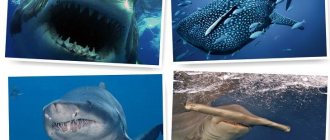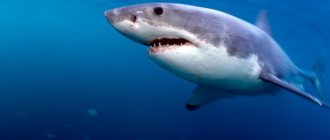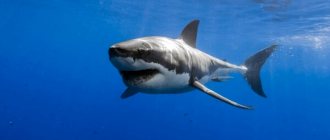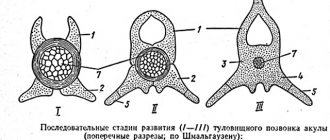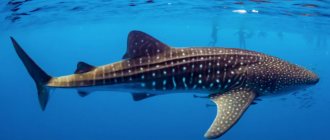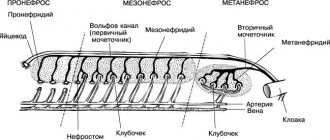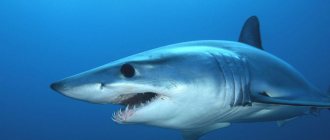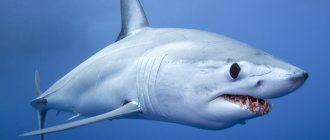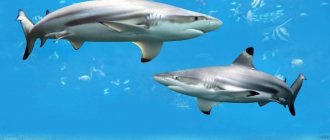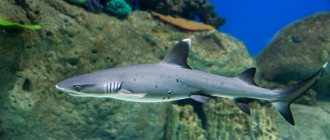Taxonomy and General Characteristics
The Black Sea shark Katran has many names. It's called:
- sand katran;
- southern katran;
- marigold;
- dogfish;
- common katran;
- spotted shark;
- shortfin shark;
- blunt-nosed shark.
All the abundance of these names refers to fish from the order Katraniformes, the family Katranidae, a genus of spiny sharks.
On average, representatives of this formidable tribe reach about a meter in length. The maximum size of a caught specimen was recorded to be just over one and a half meters.
The spiny shark has a streamlined body shape, which allows it to develop great speed. Males are smaller than females. On average, they reach sizes of 60-90 cm. Females are larger - their size ranges from 75-105 cm. Individuals weigh no more than 10 kg.
We also recommend reading:
Do-it-yourself tackle for carp Fish of the trout species: characteristics and fishing Culinary value of sea bass Tasty and healthy hominy made from corn grits
Almost all names of this fish contain the epithet “spiny”. This is due to the fact that there are sharp spines at the base of its dorsal fins. The first spine is shorter than the dorsal fin, the second is slightly longer than the other dorsal fin. This is how the sea dog protects itself from numerous enemies who want to eat it.
Its skin has small placoid scales. The general color is dark gray, sometimes with small white spots. The snout has a typically shark-like pointed shape. The eyes are relatively large, located at an equal distance from the tip of the snout and the first gill slits.
Nutrition
The Katran shark cannot be called a dangerous predator, but in those areas where its presence is high, it causes great harm to fisheries. Commercial fish are being destroyed. Katran, like all sharks, is very voracious and always hungry.
This is due to the fact that in order to breathe, he needs to constantly be in motion. This consumes a lot of energy, which he replaces with endless food intake. To satisfy its hunger, it hunts small and medium-sized fish that lead a schooling lifestyle. It can be:
- sprats;
- mackerel;
- cod,
- salmon;
- anchovy;
- herring;
- flounder;
- crab;
- seaweed;
- squid;
- anemone.
If there is not enough fish for food, then the spiny shark feeds on: jellyfish, octopuses, shrimp, crabs, and algae. Scientists have discovered that Katrans can also unite in schools to hunt dolphins. The latter become fewer where there is a large population of sharks.
Gallery: Katran shark (25 photos)
Habitats
The spiny shark is ubiquitous on the continental shelf of the temperate climate zone.
The range is extensive. It can be described as follows:
- Western Atlantic - from the island of Greenland to the coast of Argentina;
- Eastern Atlantic - from Iceland to South Africa;
- Mediterranean Sea;
- Black Sea;
- Pacific Ocean - in the areas of New Guinea, Japan, Korea, Northern China, the Bering and Okhotsk Seas;
- South coast of Australia and New Zealand.
Depending on their habitat, these fish have a number of populations. The Black Sea katran is the only representative of sharks that lives in the European part of the Russian Federation. Those sharks that swim into the Far Eastern seas of Russia belong to a slightly different, albeit related species.
Features of fishing for katran
The sea dog is most often found in the Black Sea. The Black Sea shark Katran actively bites on bait, preferably small fish: sprat, gobies, sprat. The best time to catch it is closer to autumn, when the water becomes cooler. Fishing from a boat at night in quiet bays with clear water is considered effective.
Katran meat has a delicate structure and pleasant taste and is successfully used in cooking. Of great value is the liver, which accounts for up to 25% of the weight of the fish. Shark liver contains more than 70% fat, which contains vitamins A, E and D, and this is successfully used in the pharmaceutical industry to produce drugs and dietary supplements. Cartilage is used to produce glue, skin serves as an abrasive material.
The shortfin spiny shark, or katran, is a widespread and quite numerous species, but its breeding cycle (long gestation period and late puberty) and mass prey create the possibility of reducing the population size of this species. Therefore, the katran has been assigned the status of “Vulnerable fish” .
Lifestyle
These sharks, despite their excellent ability to swim quickly and even swiftly, prefer to stay near the bottom. Perhaps this habit occurs due to the fact that they live mainly on the shelf, that is, in waters with shallow depths. For example, in the Black Sea, specimens are found both in the thickness and even at the surface of the water.
These fish are capable of making large seasonal migrations. They gather in large schools. Moreover, flocks are divided by gender and size.
Habitats: coastal zones of the seas. However, there are cases when the katran swims into river estuaries. The change in water salinity does not bother him.
Interesting Facts
Sharks constantly change teeth, replacing lost ones with new ones. Katrans are called monogamous people. They observe long-term monogamy. Each male, after choosing a partner, has the right to impregnate only his own female. It has a large thorn, the cut of which, like a tree, has annual rings that determine its age.
The scales resemble fine sandpaper, but last longer. Sometimes katrans are exterminated in pursuit of their skin, which is used for wood processing. In Canada in the 50s of the last century, the government established rewards for the destruction of this species. The reason was the great damage that was caused to the fishing industry.
Katran was the first shark to be caught for fish oil. They make seasonal migrations that follow strict rules. Sharks form large schools, divided into groups based on gender and size.
When moving, it can develop high speed, but it cannot brake sharply. The most expensive shark food is a delicious soup, which is listed in the Guinness Book of Records. It is cooked from fins. Before attacking the victim, it studies it, making circles around it and will attack if the victim is weaker.
The nutritional value of the liver of the spiny shark is high, which is obtained as an important source of fish oil and vitamins A and D. The percentage of these substances exceeds that of cod species.
In northern countries, they eat katran eggs, which contain more protein than chicken eggs. Oriental gourmets enjoy eating katran meat. You can boil, fry, smoke. They are used to prepare second courses, balyk, canned food, flour, and make shish kebab and steak.
In medicine, cartilage is used to produce medicines for people suffering from diseases of the skeletal system. The sticky substance found in the spines, fins and head bones is used to make glue.
Katran, the shark that is the first to not attack humans
Food preferences
Everyone associates the image of a shark with a stupid and aggressive predator that grabs everything. To some extent this is true. However, there are species that feed on plankton. However, this is rather an exception to the rule.
Katrans are actively included in the food chains of the seas, fortunately the shelf provides them with such an opportunity. They feed mainly on:
- mackerel;
- hake;
- gerbil;
- haddock;
- flounder;
- salmon;
- manhadenem;
- crabs;
- squid;
- octopuses;
- shrimp;
- anemones;
- jellyfish;
- algae.
In turn, this fish is a food supply for larger inhabitants of the oceans and seas. Other sharks and marine mammals, especially killer whales, feed on it. If individuals rise to the surface of the water, they become prey for birds. They are even caught by seagulls, who drag the shark ashore, throwing it onto sharp stones. The carcass is then pecked by birds of different species and sizes.
Origin of the species and description
Photo: Katran
The ancestors of sharks are considered to be hybodus, which appeared in the Devonian period. Paleozoic sharks were little like modern ones, so not all scientists generally recognize their relationship. They died out at the end of the Paleozoic era, but probably gave rise to the Mesozoic, which are already quite clearly identified with modern ones.
Then the rays and sharks separated, calcification of the vertebrae occurred, as a result of which the latter became much faster and more dangerous than before. Thanks to changes in the jaw bone, they began to open their mouths wider, and an area responsible for an excellent sense of smell appeared in the brain.
Video: Katran
Throughout the Mesozoic, sharks flourished, and then the first representatives of the order Katraniformes appeared: this happened at the very end of the Jurassic period, 153 million years ago. Even the extinction that occurred at the end of the era did not shake the position of sharks; on the contrary, they got rid of large competitors and began to dominate the seas undividedly.
Of course, a significant part of shark species also became extinct, while others had to change - it was then, in the Paleogene era, that the formation of most of the modern species, including katrans, ended. Their scientific description was made by C. Linnaeus in 1758, they received the species name Squalus acanthias.
Interesting fact: Although katrans are safe for humans, they should be handled with care to avoid injury from their thorns. The fact is that at the tips of these thorns there is a weak poison - it is not capable of killing, but still unpleasant sensations are guaranteed.
Breeding conditions
The reproduction of these fish is peculiar. They are ovoviviparous. This means that eggs (spawn) are formed, but not laid.
Their mating is internal. This happens in the spring. Eggs are formed in the dilated oviducts, located in two thin gelatinous capsules. This process of gestation of eggs inside the female's body is somewhat similar to pregnancy in birds or mammals. This pregnancy lasts from 18 to 22 months. Juveniles grown in the womb are usually born in the spring. With each litter from 1 female, about 20 fry 22-27 cm long appear.
This method of reproduction protects the young from early death at the egg stage. This increases the fertility of the species, despite the small number of individuals born per litter.
Puberty occurs depending on gender. Males become adults at the age of 11 years, reaching a length of about a meter. Females mature later - at the age of about 20 years with a height of one to one and a half meters. This fish lives for a long time, almost like a person - up to 75 years.
All about sharks
Common spiny shark (Squalus acanthias)
Widely distributed in moderately warm and moderately cold waters of the northern and southern hemispheres, but absent in the high Arctic, Antarctica, as well as in equatorial and subequatorial regions.
The number of spiny sharks in some areas is quite significant. In Russian waters of the Atlantic basin, it is common in the Black Sea, where it is called katran, and is also found in the Azov and Baltic seas. In the north, katrans are present in the Barents (near the Murmansk coast) and White Seas (local name - nokotnitsa, or marigold). The spiny dogfish shark is quite numerous in the Far Eastern Pacific waters - in the Sea of Japan, Okhotsk and Bering Seas. Characteristic features: the teeth on both jaws are identical, single-peaked, sharp. The color is grayish-brown, the back is darker, there are rare white spots on the sides of the body, the belly is light. There are two dorsal fins, each with a strong spine in front. The anal fin is absent. There are five pairs of gill slits located in front of the base of the pectoral fins. In exceptional cases, it reaches a length of more than 200 cm, the usual dimensions are 100-140 cm, with a weight of up to 15 kg. The lifespan of a katran is up to 25 years. This shark leads a schooling lifestyle in coastal waters and usually lives in the bottom layers - to a depth of 180-200 m, but is also found near the surface of the sea. The spiny shark is not found in the open ocean, but some individuals may move far from the shores. There is a known case where a spiny shark, tagged off the coast of California, was recaptured in Japanese waters after 7 years. Experts do not exclude the possibility that she made this journey along the coastline.
The food of katrans consists of various fish (herring, sardines, cod, etc.), crustaceans (crabs, shrimp), cephalopods (octopus, squid), worms and other bottom animals. Following the movement of forage fish, the spiny shark undertakes significant migrations in some areas, for example, off the Atlantic coast of the United States and in the eastern part of the Sea of Japan. In those waters where there are many spiny sharks, they cause significant damage to fisheries, eating fish in nets and on hooks, gnawing gear, and tearing nets.
Katran is an ovoviviparous species. Developing eggs are placed in the female's body in special capsules. Each capsule can contain from three to 13-15 eggs with a diameter of about 4 centimeters. Females bear their offspring for a very long time - 18-22 months (this is the longest pregnancy among sharks), and come to the shores to give birth to young. The offspring of one female ranges from 6 to 29 fry. Baby sharks are born without the slightest harm to the mother: their spines are covered with a kind of sheath of cartilage, which is shed immediately after birth, and newborns, whose length is 20-26 centimeters, can immediately use their weapons.
Katran has significant commercial importance. Its tasty and fatty meat, which does not have the ammonia smell specific to many other sharks, is valued even higher in many countries than herring. This shark is caught in large quantities in Japan, China, England, Norway and other countries. On the Black Sea, balyks are made from katran, which tastes like balyks made from sturgeon fish. The liver of a spiny shark is also used (for rendering medical fat, rich in vitamins A and D) and its skin.
You can find out more about methods of catching katran here.
For a person in the water, the katran naturally does not pose any threat, and swimming in areas abounding in this shark, including the Black Sea, is absolutely safe. However, when taken in hand, a katran can, bending, inflict deep wounds with its spines, which are all the more unpleasant since the mucus covering the fin spines apparently has poisonous properties.
(Source: “Biology. Modern illustrated encyclopedia.” Chief editor A. P. Gorkin; M.: Rosman, 2006.)
* * *
Small spiny shark (Squalus blainvillei)
This small predator occasionally enters the southern part of the Black Sea and is also found in the southeast of the Sea of Japan. The small spiny shark is also quite common in tropical waters. It differs from the common katran in its smaller size, unique head shape and very large spines on the dorsal fins. English-speaking peoples call this shark the bignose dog shark for its relatively large nostrils with folds of skin called nasal valves. The body shape of this predator resembles a katran, but has a more massive body. These fish do not even reach a meter in length - the maximum size is 95 cm. Females, as a rule, are larger than males. As for the epithet “dog shark” or “dog shark” - this is how representatives of spiny sharks are often called.
* * *
Sharp-toothed (saber-toothed) spiny shark (Scymnodon ringens).
A dark, almost black shark with large teeth in the lower jaw, forming a sharp cutting edge. The teeth of the upper jaw are small and thin. This structure of the dental apparatus apparently allows it to attack and dismember relatively large prey. The head is thick, the snout is wide and short, the mouth is very wide. The spines on the dorsal fins are small. Reaches a maximum size of 110 cm. Little is known about this species, since it lives at significant depths - 200-1600 m. Distribution: temperate and warm waters of the Atlantic and Pacific Ocean. It is found off the coast of Europe and in northern Africa (Scotland, Spain, Portugal, Senegal, etc.). and also near New Zealand. Diet: Pelagic bony fishes, benthic invertebrates. It reproduces, like most spiny sharks, by ovoviviparity - the female carries the eggs in her own body, like a living incubator. Specimens caught as bycatch are used in dried form for food, as well as for the production of fishmeal. This species apparently does not pose a danger to humans due to its small size.
* * *
Longnose spiny shark (Deania quadrispinosum).
A dark brown deep-sea shark with an unusually long, spade-shaped snout and denticles covering the body. This shark is characterized by large dorsal fins, with the back one being almost as big as the front one. Like all spiny sharks, there is no anal fin. This small (up to 114 cm) predator is rarely seen by people - its deep habitat is located at depths from 150 to 1000 m and deeper. The shark is a rare and little-studied species. It is found off the coast of South Australia, New Zealand, and in southern Africa - near Mozambique and Namibia. The basis of the diet is made up of bony fish, as well as benthic invertebrates. Reproduces by ovoviviparity. For humans, this predator can pose a danger only with its thorns.
* * *
Shortnose dog shark (Squalus megalops)
Distributed in the western Pacific and eastern Indian Oceans, off the coast of Australia. A deep-sea species - found at depths from 30 to 750 m. This is a small shark - the largest specimen caught reached a length of 71 cm. The muzzle is short, the mouth is small. The color of the dorsal side of the body is gray-brown, the ventral side is ash-white. The tips of the dorsal fins have dark spots, and the edges are light. This is especially noticeable in young individuals. It feeds on bony fish, crustaceans, mollusks and other invertebrates. It reproduces by ovoviviparity - after a two-year pregnancy, the female gives birth to 2-4 cubs. When caught in bottom fishing gear, they are used as food in dried, salted and smoked form. This little predator poses no danger to humans.
* * *
Green-eyed dogshark (Squalus mitsukurii)
This small but massive predator is distributed in the western Indian and central Pacific oceans, preferring temperate, warm and tropical latitudes. Found off the coast of Mexico, Hawaii, Philippines, South Africa, Australia, Tasmania and other places. Prefers depths of more than 150 m. Body length reaches 110 cm. Color is dark brown, belly is white. There are subtle light spots on the sides. The tips of the fins are also light.
* * *
Spiny dog shark (Oxynotus bruniensis)
Distributed off the coast of Australia and New Zealand. It is found at depths from 45-1070 m, but prefers the depth range from 350 to 650 m. It is distinguished by a very high body and large dorsal fins-sails. Body color is dark brown. It grows to a length of about a meter, but the usual dimensions do not exceed 75 cm. The species is viviparous.
* * *
Velvet belly shark (Etmopterus spinax)
Distributed in the eastern part of the Atlantic Ocean: from Iceland, Norway and the western Mediterranean Sea to Morocco, Senegal, Nigeria, South Africa. The northern borders of the distribution area are in the fjords of Norway. Lives at depth (300-1000 m). Reaching 60 cm in length, with a maximum weight of 850 grams, this is one of the smallest known shark species. It feeds on deep-sea squids and crustaceans. The female brings 10-20 cubs in summer, only 10-12 cm long.
* * *
Southern lantern shark (Etmopterus granulosus).
Distributed in the southeastern Pacific and southwestern Atlantic oceans. It lives at a depth of 220-1460 m. Dark brown body color, large dorsal fins armed with spines. Reaches 60 cm in length. It feeds on bony fish, squid, shrimp and crabs. Ovoviviparous species. The female brings up to a dozen cubs in a litter.
* * *
Smooth glow shark (Etmopterus pusillus).
Distributed in the Atlantic, western Indian, and western Pacific oceans at depths of 250-1000 meters or more. This is a small predatory fish, reaching a length of only 50 cm. The slender body appears smooth due to small scales, the head is relatively large, with an elongated snout. The eyes are large, oval, capable of glowing in the dark. The dorsal fins have spines. The posterior dorsal fin is noticeably larger than the anterior one. The teeth of the upper jaw are narrow, with tiny additional tips on the sides. On the lower jaw, the teeth form a continuous cutting edge. They feed on small fish, squid, animal larvae and fish eggs. They reproduce by ovoviviparity, with up to 10 young in a litter. The average life expectancy is 14-17 years.
* * *
Birdbeak shark (Deania calcea)
This amazing shovelnose shark lives on the bottom, on the outer continental slopes, at depths of up to 1500 m. The color is dark gray, the belly is lighter. There are two dorsal fins, each with a small spine. Large eyes and small cutting teeth help it find and capture prey at depth. The unique nose of these sharks is a “repository” of various sensory receptors. Size: Up to 1.1 m. Females are slightly larger than males - up to 122 cm. Distribution: Tropical and temperate waters; most common in the Northeast Atlantic. Diet: Bottom-dwelling bony fish and molluscs. Reproduction: Ovoviviparous, 6-12 cubs per offspring. Not dangerous to humans, but should be handled with care due to the thorns.
* * *
Black shark (Dalatias licha)
It lives in the Atlantic, western Indian, and western Pacific oceans at depths of up to 1800 m. The shark has a slender, thin body with a blunt snout, thick lips and large eyes. The body color is black or dark brown, the lips are pale pink. The tips of the fins and trailing edges are translucent. There are sometimes small dark spots on the sides. The teeth of the upper and lower jaws are different - the upper teeth are small and narrow, the lower teeth are large, with triangular apices that form a continuous cutting edge. The body length reaches 160 cm, the average length does not exceed 140 cm. The black shark is a solitary predator, the diet of which consists mainly of bony fish, smaller sharks, crustaceans and bottom organisms. This shark is viviparous, with a litter of 10-14 pups. The black shark has some commercial value for its meat, skin, and liver, especially in Portugal and Japan. Intensive fishing for this fish has led to a sharp reduction in its numbers.
* * *
Southern dogfish (small needle shark) (Centrophorus uyato)
This shark has a slender body with a slightly humped back near the anterior dorsal fin. Reaches a length of 110 cm. The body color is brownish-gray, the ventral side is lighter. It lives in the eastern Atlantic - from Spain to southern Africa, along the coast of the Indian Ocean, as well as in the Gulf of Mexico and the Caribbean. It prefers to live at depths from 200 to 1400 m. It reproduces by ovoviviparity, with only one cub per litter.
* * *
Longnose spiny shark (Centroscymnus crepidater)
Another deep-sea species of spiny sharks. It lives at depths from 230 m to 1500 m. Widely distributed in the World Ocean - in the Eastern Atlantic: from Iceland to Namibia. In the waters of Australia and New Zealand, along the coast of Chile and other places. Slender body with a very long nose and small spines on the dorsal fins. The body color is black or black-brown. It reproduces by ovoviviparity, with a litter of 4-8 young. Reaches a length of 130 cm. They feed on small fish, shrimp, squid, and bottom invertebrates. Specimens caught in bycatch are used to make fishmeal. According to some sources, the meat of these sharks contains high levels of mercury.
* * *
Portuguese shark (Centroscymnus coelolepis)
This fish is considered the deepest-sea shark known. Individual specimens of these predators were caught from a depth of 3675 m. They are widely distributed in the waters of all oceans. except for the Arctic. It is numerous along the western and eastern shores of the Atlantic, in the Indian Ocean it is found near the Seychelles Islands, in the Pacific Ocean - from Japan to New Zealand. It prefers to inhabit the outer areas of the continental shelf, at significant depths. Reaches 120 cm in length. The body is thick, cylindrical, the stomach is flat. The dorsal fins are small, pectoral fins with rounded tips. Caudal fin with a more developed upper lobe. The body color of young individuals is blue-black, becoming dark brown with age. There are no noticeable spots on the body and fins. Has very sharp eyesight. It feeds mainly on cephalopods (squid), as well as small fish. Sometimes even jellyfish were found in the stomachs of Portuguese sharks. For a long time, Portugal was the only country that hunted Portuguese sharks. The liver of these predators, which contains large amounts of squalene, is highly valued. Meat is less valued due to reports of high mercury content. This species does not pose a danger to humans due to its small size and deep-sea lifestyle.
* * *
Spiny sharks are one of the smallest cartilaginous fish, less than the length of a human palm.
Dwarf shark (Euptomicrus bispinatus)
The maximum length of females of these sharks is 25 cm, males are even smaller. This is a deep-sea predatory fish that lives in the warm waters of the Indian and Pacific oceans. During the day it makes vertical migrations - at night closer to the surface, during the day - into the depths. The body of these sharks is capable of glowing due to areas that produce fluorescent substances. Despite its tiny size, this fish easily deals with fairly large prey, thanks to its sharp and large teeth. It feeds on squid and bony fish. Ovoviviparous species, litter includes up to ten sharks. For obvious reasons, this shark is not dangerous to humans.
* * *
The Ubiquitous Cat Sharks
Use in cooking
This fish is considered a commercial fish and is in great demand in many countries. The fishery is especially developed in Japan, China, Norway, and Great Britain.
Its meat is considered nutritious. It contains 142 kcal, 20% protein, 7% fat, but no carbohydrates at all.
At the same time, fish meat contains: cobalt, sulfur, iodine, potassium, chromium, phosphorus. Of the biologically active substances, the product is rich in retinol, niacin, and tocopherol.
In addition to meat, they also eat liver and cartilage, which are considered delicacies. In addition, it is believed that they contain substances that improve human health. In particular, they improve hematopoiesis, reduce the intensity of inflammatory processes, and activate the immune system.
Katrana can be salted, dried, smoked, fried, boiled. The famous soup is prepared from the fins of this particular shark.
A fat called squalene is rendered from the liver. It is considered the lightest of all animal fats. It contains large amounts of vitamins A and D. It is used in medicine and is also used for technical purposes. Ointments are made from shark oil and used to treat joints.
Fins are used not only in cooking, but in medicine and even for technical purposes. For example, shark cartilage and skin are used to make tools that have abrasive properties. In addition, glue is made from fins and cartilage, and pepsin is produced from stomach tissue.
In addition to the delicious shark fin soup, smoked balyki, which are not inferior in taste to the famous smoked eel, are especially valued.
An intermediate product of smoked balyk is salted katran meat.
To prepare it, a large carcass is cut into pieces of the required size. They are cleaned, washed and immersed in a saline solution for two hours. After this, the pieces are washed. They can be eaten immediately or smoked.
Stewed katran is prepared as follows. Pour a small layer of vegetable oil onto the bottom of the saucepan in an amount sufficient to cover the bottom with oil.
You need to remove the skin from the fish, cut the meat into cubes or thin slices (as you like), and place it on the bottom. Place a layer of onion, cut into slices, on top, then again you need to place pieces of fish, and onion on them. If desired, you can place a layer of grated carrots on top of the fur coat. All this needs to be salted, peppered, sprinkled with spices, brought to a boil and simmered over low heat for 30 minutes without stirring. When everything is ready, you need to add chopped herbs on top. You can add apple cider vinegar or lemon juice to the onion layer.
Natural enemies of katrans
Photo: What does katran look like?
Adult Katrans can only be threatened by killer whales and larger sharks: both of them are not averse to snacking on them. In confrontation with them, the katrans have nothing to count on; they can only injure killer whales, and even then quite weakly: their teeth are too small for these giants.
Getting into fights with larger sharks is also a disastrous proposition for katrans. Therefore, when meeting them, as well as killer whales, all that remains is to turn around and try to hide - fortunately, speed and endurance allow you to count on a successful escape. But you can’t hesitate to do this—you just have to hesitate, and you could end up in the teeth of a shark.
Therefore, katrans are always vigilant, even when they are resting, and are ready to run. They are in greatest danger when they themselves are hunting - their attention is focused on the prey, and they may not notice how a predator swims up to them and prepares to attack.
Another threat is humans. Katran meat is highly valued; balyk and canned food are produced from it, and therefore they are caught on an industrial scale. Every year, people catch millions of individuals: most likely this is much more than killed by killer whales and all sharks combined.
But in general, it cannot be said that an adult katran faces many dangers, and most of them successfully live for several decades: however, only if they manage to survive the first years of life, because they are much more dangerous. Medium-sized predatory fish, as well as birds and marine mammals can prey on fry and young dogfish.
Gradually, as the threats grow, there are fewer and fewer threats, but the katran itself turns into an increasingly formidable predator, exterminating even some of the animals that threatened it earlier - thus, predatory fish suffer from it.
Interesting fact: Although katran meat is tasty, you should not get too carried away with it, and it is better for small children and pregnant women not to eat it at all. There are simply too many heavy metals in it, and too much of them is harmful to the body.
